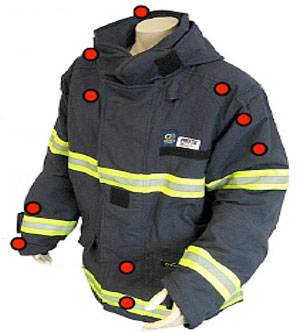KANBrief 1/16

Personal protective equipment (PPE) is continuously being further developed to meet the needs of both professional and private users. One of the trends is towards ‘smart PPE’ or even ‘smart personal protective systems’ (PPS). Whereas the first such products are already commercially available, the market introduction of complex PPE primarily intended for professional use appears to face challenges that have yet to be overcome.
In recent years, several research institutes and companies have worked on projects concerning PPE and PPS, in some cases co-funded by the EU or national/regional authorities. Examples include:
These applications all require electronic elements to be included in the protective equipment. Smart systems also require a (wireless) link to external equipment. This allows a responsible person (e.g. a safety manager, fire chief) to intervene whenever a crew member needs to be warned of a risky situation or is in need of assistance.
Products not yet ready for the market
It goes without saying that the added elements must not pose new risks or discomfort for the wearer and must function correctly under all foreseeable conditions of use. When a firefighter’s safety or perhaps even his life depends on correct information being received from the electronics incorporated within his PPS, it is essential that they function correctly even at high temperatures or inside a smoke-filled building. The retention of this functionality must be tested. For this purpose, agreement must be reached on the minimum requirements for the technical reliability of the systems. Back-up systems may have to be provided.
As long as no standardized method exists for the testing of these elements, neither employers nor employees will have confidence in technical solutions of this kind – even if the added value is universally recognized.
Nor can security and privacy issues be ignored. The systems must be protected in an effective way against interference by hackers. When body functions are monitored, in particular, protocols must be agreed on how the data can be managed such that the privacy of the wearer is not compromised.
Manufacturers must also pay attention to the ergonomics of the system. A person wearing protective clothing, footwear, gloves combined with head and respiratory protection and possibly with fall protection will need all parts of the equipment to be perfectly compatible. Smart elements must be integrated with each other such that the wearer receives information from a single source, as a risk is otherwise presented of ‘information overload’: the wearer of the system either concentrates permanently on the warnings and information he or she receives – or simply ignores them.
Certain changes to the legislation would support the introduction of smart PPE and PPS. This equipment is no longer subject solely to the PPE legislation, but also to other legal acts such as the Radio Equipment Directive and the Directive on Electromagnetic Compatibility. However, harmonization between different legal acts is not always a reality, and practical guidance remains lacking. In order to demonstrate compliance with all applicable legislation, multiple notified bodies may have to be involved. The same applies to market surveillance authorities.
In many cases, these challenges can be tackled by standards and best-practice guides. Efforts are being made at CEN/CENELEC to begin work on standards and technical reports. To ensure that the potential is realized, cooperation between experts from different disciplines is crucial.
Henk Vanhoutte
henk.vanhoutte@eu-esf.org